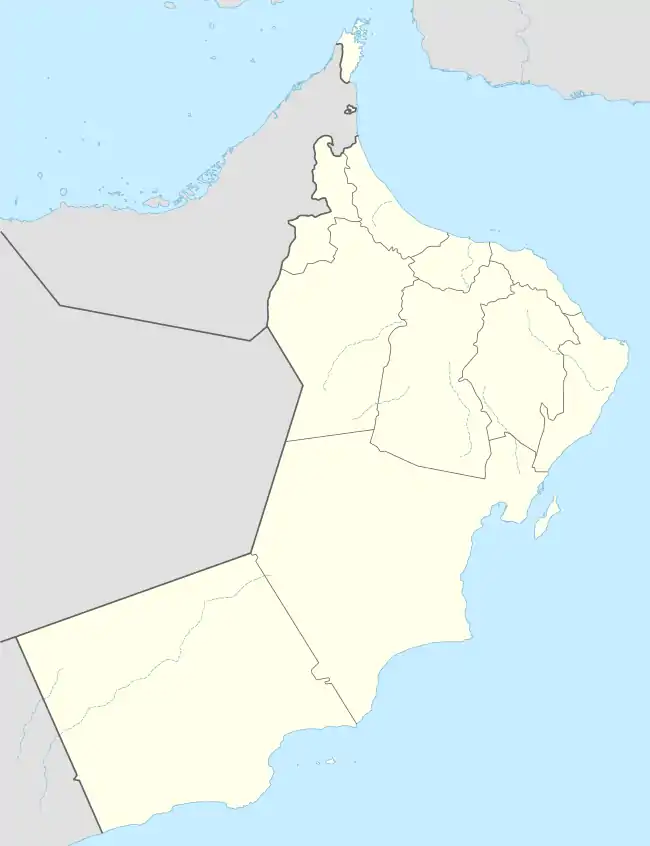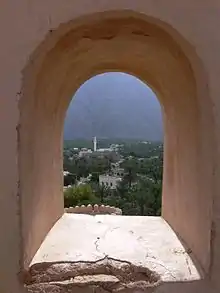Nakhal Fort
Nakhal Fort (Arabic: قَلْعَة نَخَل, romanized: Qalʿat Nakhal) is a large fortification in Al Batinah Region of Oman. It is named after the Wilayah of Nakhal. The fort houses a museum, operated by the Ministry of Tourism, which has exhibits of historic guns, and the fort also hosts a weekly goat market.
| Nakhal Fort | |
|---|---|
قَلْعَة نَخَل (in Arabic) | |
| Nakhal, Al Batinah South Governorate, Oman | |
.jpg.webp) View of Nakhal Fort | |
 Nakhal Fort | |
| Coordinates | 23.395°N 57.829°E |
| Type | Fort |
| Site information | |
| Open to the public | Yes |
| Site history | |
| Built | Pre-7th century, refurbished in 17th century, extend in 1834 |
| Built by | Imam Said bin Sultan in 1834 |
History
The fort, also known as Husn Al Heem, was named after the state of Nakhal that exists above the old village of Nakhl.[1] It has a history which dates back to the pre-Islamic period when it was originally built by the Sassanids as a bulwark against incursions by Arab tribes. Imams of Wadi Bani Kharous and the Ya'arubah dynasty resided here in the past. Over the centuries, it underwent many renovations and improvements. It was reconstructed by Omani architects in the 17th century. Initially built as a protective measure for an area oasis and nearby trade routes, it passes through the regional capital of Nizwa. The gateway and towers seen now were extensions built in 1834 attributed to imam Said bin Sultan. In 1990, it was fully renovated.[1]
In November 2003, Prince Charles visited the restored fort during an official visit to Oman.[2][3]
Overview

The fort is approximately 120 kilometres (75 mi) to the west of Muscat, the capital of Oman, at the entrance of Wilayt Nakhal in Wadi Ar Raqeem.[4] It is situated on a rocky prominence at the foot of Jebel Nakhal, a spur of the main Western Hajar range.[4][3] It is to the northeast of Jabal Akhdar also called green mountain.[4] Nakhal Fort is surrounded by orchards of palm trees. Its battlements provide a view of the Al-Batinah Region.[4] The ancient Nakhal village is below the fort and close by is the warm springs of Ain A'Thawwarah.[5] Nakhal Fort is one of several fortifications in the Al Batinah Region, the others being Al Hazim, Al-Sifalah, Rustaq, and Shinas forts.[6]
Built in the architectural style of the Sultanate of Oman, it is unique in that it was built to fit around an irregularly-shaped rock,[7] with some rock exposures jutting out into the interiors. The fort houses a museum,[8] operated by the Ministry of Tourism with exhibits of historic guns.[9] A weekly Friday goat auction market takes place within the precincts of the fort.[5] During recent renovations the fort has been fitted with traditional furniture, handicrafts and historic artifacts.[1]
References
- "Living Landscapes of Oman: Fourth International Conference Responsible Tourism ..." Sultanate of Oman. Archived from the original on 27 September 2013. Retrieved 24 September 2013.
- "HRH visits the restored Nakhal Fort in the Sultanate of Oman". The Prince of Wales and the Duchess of Cornwall News and Diary. 7 November 2003. Retrieved 23 September 2013.
- "Prince Charles denies 'ludicrous' claims". BBC News. November 7, 2003. Retrieved 28 September 2013.
- Walker & Butler 2010, pp. 172.
- "Museums". Nakhal Fort Museum. Ministry of Information. Archived from the original on 2 May 2008. Retrieved 22 September 2013.
- IBPUS 2009, p. 238.
- "Fort Nakhal". Ministry of Tourism (Oman). Retrieved 22 September 2013.
- Oxford Business Group 2010, p. 255.
- "Museum Timings". Oman Tribune. Archived from the original on 22 September 2013. Retrieved 24 September 2013.
- Bibliography
- IBPUS (20 March 2009). Oman Royal Police Handbook. International Business Publications. ISBN 978-1-4387-3690-7. Retrieved 27 September 2013.CS1 maint: ref=harv (link)
- Oxford Business Group (2010). The Report: Oman 2010. Oxford Business Group. ISBN 978-1-907065-13-2. Retrieved 22 September 2013.CS1 maint: ref=harv (link)
- Walker, Jenny; Butler, Stuar (2010). Oman, UAE & Arabian Peninsula. Lonely Planet. p. 24. ISBN 978-1-74179-145-7. Retrieved 22 September 2013.CS1 maint: ref=harv (link)
External links
 Media related to Nakhal Fort at Wikimedia Commons
Media related to Nakhal Fort at Wikimedia Commons
